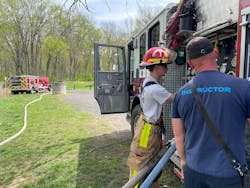Using Technology for Training Volunteer Firefighters
The public’s expectation for emergency services is rather simple: When the call is made for assistance, it’s expected that well-trained individuals arrive and can address the problem.
As an all-hazard service, the fire service has the burden of having to be prepared to address almost anything.
Volunteer training officers have an additional challenge: training members who, on a normal basis, have limited availability and minimal contact time with the department, (often a couple of hours per week) for drilling. Nevertheless, members can be effectively and consistently trained. Options are traditional classroom, hands-on or practical skills training, web-based training and a combination of the above.
The volunteer training officer must maintain a delicate balance with busy members to maintain training to meet the standards of service that are required by the industry and expected by the public and to respect the other time commitments that volunteers have. Furthermore, the onset of COVID-19 forced change in how we train our members, in some ways, for the better.
Online meetings
Volunteerism is declining, and fire service standards for training are increasingly demanding. (In Connecticut, current course time for Firefighter I is 175 hours, including hazmat operations, review and exam days.)
To maximize volunteer training time, departments must look beyond the traditional approach of having members drive to the firehouse, sit through training and do the same the following week (or worse, not have a weekly training plan and make something up on the go). This deteriorates member interest, and other commitments quickly can take priority over the member’s commitment to the department.
Training must be relevant to the member’s job, interesting in how it’s presented, informative and time efficient. Some annual refresher courses are, on the surface, dry, redundant topics, but adding new and different speakers and perspectives on the topics might provide a needed fresh view.
Technology and its expanded use in the past year and a half has had an effect on the training of volunteer firefighters. As COVID-19 protocols were put in place, and members, to avoid the spread of the virus, had limited access to fire stations, fire departments suddenly had to shift how members trained. Technology that was in place prior to the pandemic but used on a limited basis became the prevalent method of training, particularly early on.
When planning training via technology, several options must be explored: live, online meeting hosts, such as Google Meet, Microsoft Teams, Zoom, etc.; paid learning management systems (for example, Vector Solutions); webinars; and industry-specific training lessons that are offered by insurance companies, often at no cost to insured customers (VFIS University, Provident FirePlus Online Training & Education Platform, and McNeil & Co. Webinars and Resources for Emergency Services Organization, etc.).
Online meeting hosts allow a group to hold live meetings via both video and audio options, whether on mobile devices (smartphones and tablets) or desktop computers. Thus, they are a good option for live, instructor-led training sessions. Unlike a webinar, a live meeting also allows students to engage with the instructor.
The host sites range from no cost to paid subscriptions, with multiple options available in between. A basic, no-cost plan allows a limited number of users to attend a meeting that has a rather short window (normally no more than one hour). This option works for small group meetings that have short meeting agendas. Paid subscriptions give users longer or unlimited meeting times, allow for larger groups and have meeting recording available.
With the limited availability of volunteer time, host meetings that include recording options allow members who can’t attend a meeting to view it later.
Learning management systems
Learning management systems (LMS) are subscription-based online training systems that provide industry-specific training on a variety of topics. Training officers can assign courses to members based on required training (for example, annual bloodborne/airborne pathogen refreshers) as an introduction to an upcoming class or topic, for promotional reasons or for remedial purposes (for instance, an EVOC class because of a motor vehicle violation). By using an LMS, a training officer ensures that the members receive consistent training. When assigning the course, the instructor has the ability to electronically notify the member of the assignment and to set automatic reminders for the member (via email) that an assignment is due or past due (based on the due date that was set by the training officer). Most LMS are set up to ensure that the student commits to at least the full amount of time that’s designated for a course, by not allowing the student to skip past or fast forward video and audio playbacks.
One downfall to courses that are studied via an LMS is that there’s no capability to interact with the instructor or presenter. Also, training officers must understand regulations for particular topics before choosing a generic course on an LMS. For example, the state of Connecticut’s Commission on Human Rights and Opportunities (CHRO), which is based on state statutes, regulates the requirements for sexual harassment prevention training; as part of the training, state employees must have the ability to interact with the instructor. A generic online course that lacks access to the presenter doesn’t satisfy the state training requirement. Although the course that’s presented by CHRO is online, the interactive requirement is met by having CHRO staff available for questions.
A tool that’s available with an LMS is the capability to upload department-specific training. A training officer who has access to an LMS and an online meeting host app can assign a recorded training to members via the LMS. Custom department-specific training allows the training officer to replace or supplement canned training. For example, an LMS might provide a standard course on water supply/drafting. Supplementing the course with the location of cisterns and dry hydrants, specific adapters that are needed to access these water supplies and adapters’ locations on the apparatus improves the lesson.
Policy changes
With the capability to upload department-specific training, a department also might choose to post new or revised department rules for member review on the LMS. As most department administrators are aware, members aren’t likely to review department policies when the policies are provided via a link to a website or via email. Utilizing the LMS, the department can assign members the task of reviewing new and updated policies. The administrator can track when members do so, and the members acknowledge that they read, reviewed and understand the policy. No longer can members say, “I didn’t know about this.”
All this said, uploading a large number of rule changes all at once might overwhelm some members. When making these rule/policy changes, only make changes that are based on what you believe that your members can tolerate at one time.
An LMS gives training officers the ability to electronically track members’ training history. Historically, administrators relied on members to present them with a paper copy of a training certificate. Implementing an LMS eliminates the need for paper tracking. The program administrator accesses each member’s training profile, including courses that were completed successfully. (Members can print certificates of completion from their portal.)
Access to member training records serves the administration in the event that it’s requested or required to produce those records. At minimum, training officers should reference NFPA 1401: Recommended Practice for Fire Service Training Reports and Records.
Departments also must be familiar with 29 CFR 1910 (general industry OSHA standards). Included in 1910 are training requirements—for example, 1910.132(f)(1)’s “The employer shall provide training to each employee who is required by this section to use PPE.”
Detailed training records, including any online courses that were taken, will be critical in the event of an audit or inspection. Departments that seek ISO certification also need documentation of training.
More LMS benefits
Members who need continuing education for recertification (fire marshal, EMS, etc.) benefit from LMS use. Courses that are pre-approved for recertification credit are available on the systems.
Besides providing training courses, some LMS offer asset-management and risk-management add-ons, among others.
When interviewing LMS providers, departments should look for a product that not only meets their immediate needs but can fulfill future needs as well. Very often, it’s more cost-effective to have one, rather than multiple, software providers. Members might find it easier to learn the nuances of an add-on for an existing product rather than learning multiple platforms.
Departments that research software should be aware of the benefits and disadvantages of best-in-class vs. best-in-suite products before they make a final purchase decision; there are advantages and disadvantages to both of those types.
Free options
Not every department can provide its members with access to paid subscription platforms for online training. There are very good no-cost training options.
Insurance carriers have a vested interest in making certain that their insured departments receive adequate training. As such, some (i.e., VFIS, Provident and McNeil & Co.) provide online training for the departments that they insure. Members might need to provide proof of membership before gaining access to these services.
The National Fire Academy is another excellent resource of no-cost online training in the realms of self-study and instructor-led training courses.
Webinars from industry organizations provide experts in a particular subject to share their wisdom in 30–60-minute sessions. Most webinars are available live, often with the capability to permit questions to be asked of the presenter. Of course, recorded webinar sessions lack the interactive capability.
Fire service organizations, such as the International Association of Fire Chiefs and the National Volunteer Fire Council, offer webinars at no cost because of corporate sponsorship for the session or as a benefit to membership.
Scenarios in which traditional, live instructor-led training are best. Such scenarios include topics that are new to the student, particularly when the student is new to the fire service. As is the case of live online meetings, live instructor-led trainings afford dialogue.
Once instructor-led classroom training is done, some training requires hands-on, in-person training evolutions that can’t be accomplished online. Students can take the skills that were learned in the classroom and apply them in the field.
Refresher training is an opportunity for a mix of online training and hands-on training: hazmat operations refresher training, for example.
Not in a vacuum
Training officers must know and understand the learning preferences—and potential limitations—of members. Some lack access to technology (they might not have a smartphone, a tablet or a computer or might live in a remote area that lacks reliable internet access). Furthermore, some members might not be comfortable using technology or simply might learn better in a traditional classroom setting.
No one piece of technology is a fit for every department. When inquiring about implementing technology to enhance your training division, certain considerations must be made: budget, end-user accessibility (to hardware and internet access), compatibility to end users (will the end user adapt to using the technology?), department needs and training plans.
More Focused via Polling
Ken Sedlak
Kenneth Sedlak is the assistant chief of administration for the Avon, CT, Volunteer Fire Department. He has been with the department since 2002. Sedlak holds an associate degree in telecommunications technology from Springfield Technical Community College, a bachelor’s degree in business from Albertus Magnus College and a Juris Doctor degree from Quinnipiac University School of Law.









